Okay, let’s address the elephant in the room—most gaming bedroom setups look absolutely terrible. I’m talking about that classic combo of unmade bed, tangled cables everywhere, energy drink cans forming geological layers on every surface, and RGB lighting that looks like a rave threw up in your sleeping space.
The problem is that most people approach gaming bedrooms like they need to choose between having a space that’s good for gaming OR good for sleeping, but never both. So you end up with bedrooms that are either completely optimized for gaming but impossible to relax in, or bedrooms that look nice but make gaming feel like an afterthought crammed into whatever corner was left over.
But here’s what I’ve figured out after seeing way too many bedroom disasters: the best gaming bedrooms work because they understand that good design makes everything better. Better gaming experience, better sleep, better productivity if you work from home, and honestly, better mental health because your space actually supports how you want to live instead of fighting against it.
You don’t need to sacrifice style for functionality or give up serious gaming performance to have a bedroom that doesn’t look like a tech disaster zone. The key is understanding how to integrate gaming into your bedroom in ways that enhance both activities rather than compromising either one.
Ready to create a bedroom that’s actually great for both gaming and sleeping? Let’s talk about setups that work in the real world.
Stop Making Your Bedroom Uninhabitable
Before we get into the solutions, let’s talk about the common mistakes that turn bedrooms into spaces you tolerate rather than enjoy.
Gaming Noise Versus Sleep Quality – Your mechanical keyboard and cooling fans might sound awesome during gaming sessions, but if they’re keeping you awake or bothering neighbors, you’ve got a fundamental design problem that needs solving.
Light Pollution Reality – All those RGB strips and monitor glows look cool but can seriously mess with your sleep patterns if not managed properly. You need lighting that works for both gaming ambiance and actual rest.
Space Flow Matters – Bedrooms need clear pathways and zones that don’t conflict with each other. If you’re constantly moving gaming gear to make your bed or can’t access your closet without climbing over cables, your layout needs work.
Temperature and Air Quality – Gaming hardware generates heat, and bedrooms need good ventilation for sleep quality. Plan for both or you’ll end up with a space that’s either too hot for gaming or too noisy for sleeping.
Design for Real Life, Not Just Gaming Sessions
The best gaming bedrooms understand that you live in this space for more than just gaming—you sleep, get ready for work, possibly take video calls, and need somewhere to decompress at the end of the day.
Transition Planning – Think about how your space needs to transform throughout the day. Gaming mode in the evening, sleep mode at night, maybe work mode during the day. The best setups make these transitions easy rather than requiring major reconfiguration.
Dual-Purpose Furniture – Every piece in your bedroom should serve multiple functions when space is limited. Gaming chairs that work for desk work, storage solutions that hide gaming gear when not in use, lighting that serves both tasks and ambiance.
Sound Management – Consider how gaming audio affects your sleep schedule and relationships. Headphone storage, sound dampening, and setup positioning that doesn’t blast noise toward sleeping areas all matter.
Visual Balance – Your bedroom should feel cohesive rather than like gaming gear was randomly inserted into a sleeping space. Color coordination, cable management, and thoughtful equipment placement make everything feel intentional.
13 Gaming Bedroom Ideas That Actually Work
1. Bedside Command Station
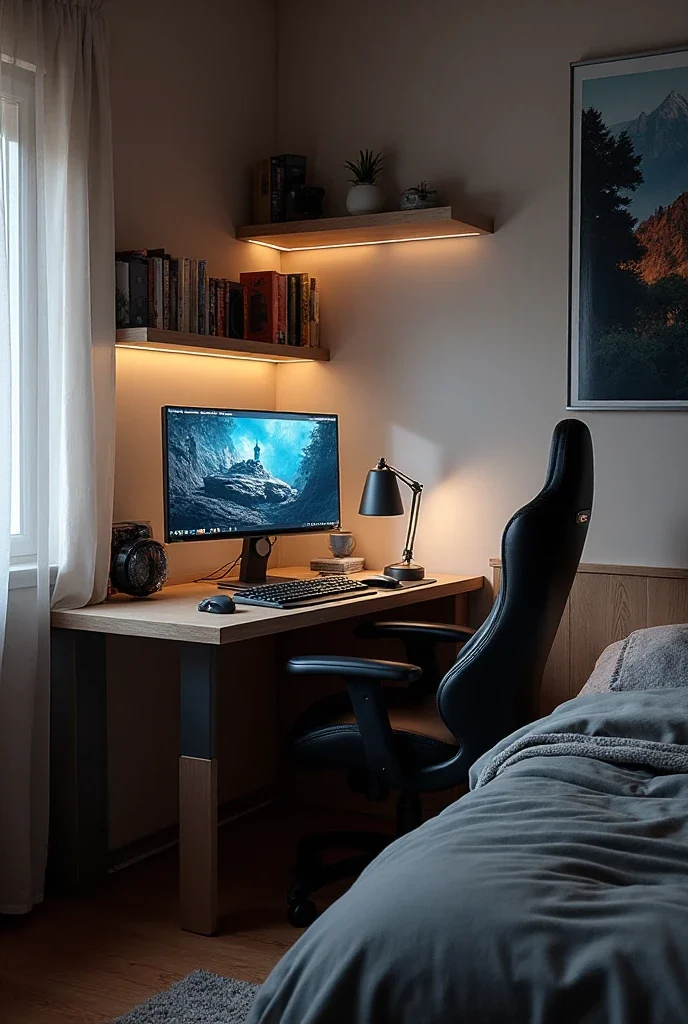
Position your gaming setup right next to your bed for easy access without dominating the room. Compact desk with dual monitors creates serious gaming capability while maintaining bedroom proportions and flow.
The key is keeping everything scaled appropriately—you want full gaming functionality without making the setup feel oversized for bedroom use. Neutral bedding and subtle LED strips create visual continuity between sleeping and gaming areas.
This works particularly well in smaller bedrooms where every square foot matters. The proximity makes late-night gaming sessions convenient while keeping daytime bedroom use completely normal.
2. Vertical Space Optimization

Loft beds with gaming setups underneath maximize floor space while creating distinct zones for sleeping and gaming. The elevated bed creates a cozy sleeping nook while the gaming area feels like its own dedicated space.
RGB lighting under the loft creates atmosphere without interfering with sleep quality above. Cable management becomes crucial since everything is visible from multiple angles, but when done well the effect is incredibly sophisticated.
This approach works best for people comfortable with loft beds and who want to maximize small bedroom space without sacrificing either sleeping or gaming quality.
3. Dual-Purpose Productivity
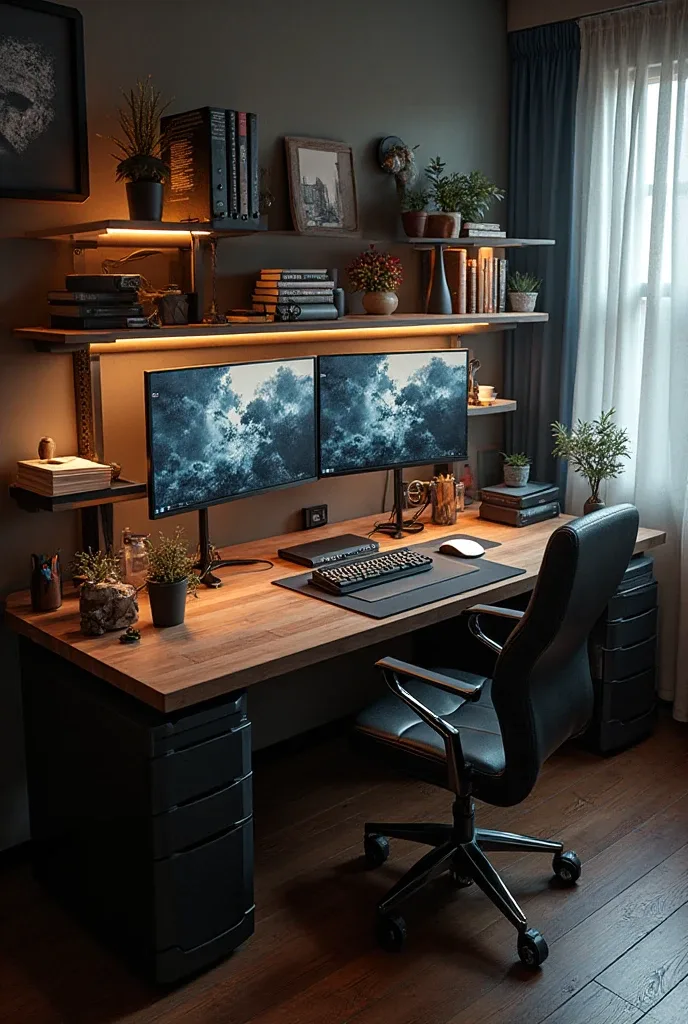
One long desk serving both study and gaming functions prevents the gaming setup from taking over your entire bedroom. Left side for productivity and organization, right side optimized for gaming with appropriate lighting and equipment.
The unified desktop creates visual cohesion while allowing completely different functionality on each end. When you’re not gaming, the space reads as a sophisticated work area rather than a gaming setup with some books randomly placed nearby.
This works especially well for students or remote workers who need their bedroom to handle multiple types of activities throughout the day.
4. Entertainment Theater Setup
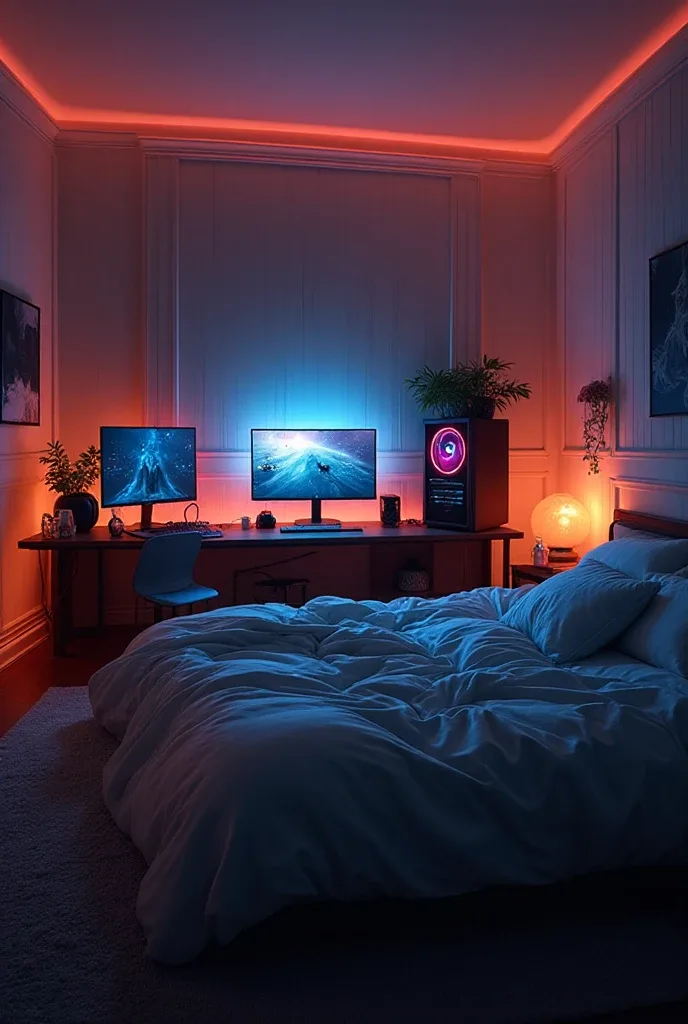
Position your bed to face a wall-mounted gaming setup for comfortable gaming from bed when you want to relax. Large monitor and proper cable management create a clean entertainment center that works for gaming, streaming, or work video calls.
The key is mounting everything at the right height for comfortable viewing from bed while maintaining good ergonomics when seated at the desk. Ambient wall lighting prevents harsh monitor glow from dominating the room.
This layout works well for people who want flexibility between serious desk gaming and casual gaming from bed, creating options for different moods and energy levels.
5. Floating Minimalism
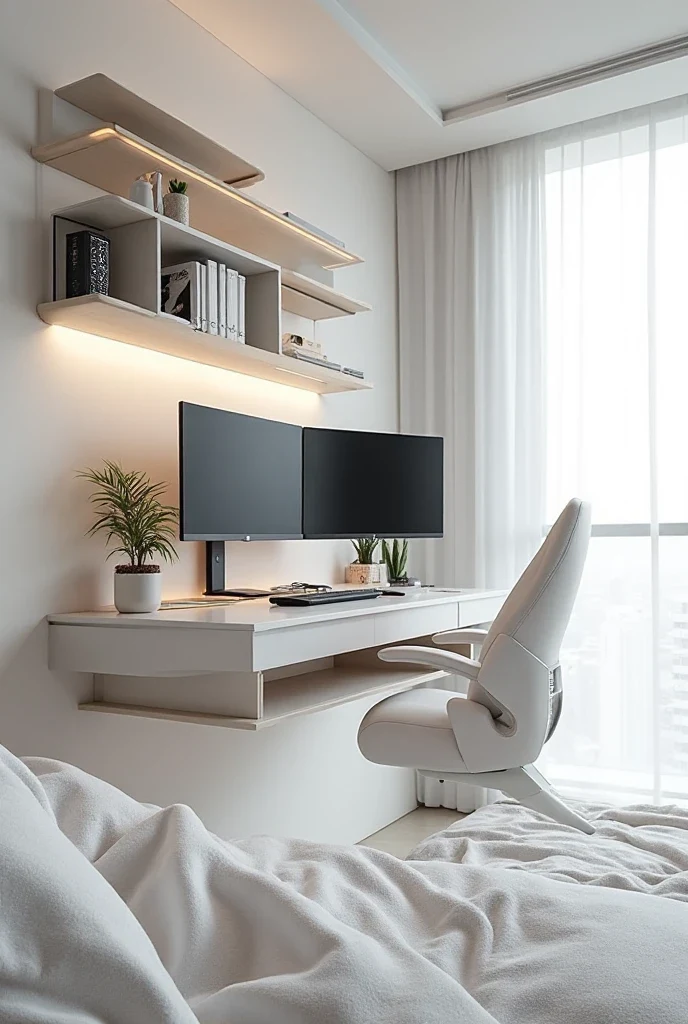
Wall-mounted desk systems keep floor space open while providing full gaming functionality. The floating effect makes small bedrooms feel larger while maintaining all the performance you need for serious gaming.
Under-desk lighting creates visual weight that grounds the floating desk while providing ambient lighting for both gaming and general bedroom use. Cable management must be perfect since everything is visible and mounted.
This modern approach works particularly well in contemporary bedrooms where clean lines and minimal visual clutter are priorities.
6. Integrated Ambient Design

RGB LED strips that coordinate between your bed frame and gaming setup create visual harmony rather than competing lighting schemes. The ambient lighting serves both gaming atmosphere and general bedroom mood lighting.
Choose colors and intensities that work for both activities—gaming excitement and bedroom relaxation. Smart lighting systems let you adjust throughout the day without manual switching between different modes.
This approach prevents your gaming setup from feeling like foreign equipment inserted into your bedroom by making the lighting feel integrated and purposeful.
7. Console Simplicity
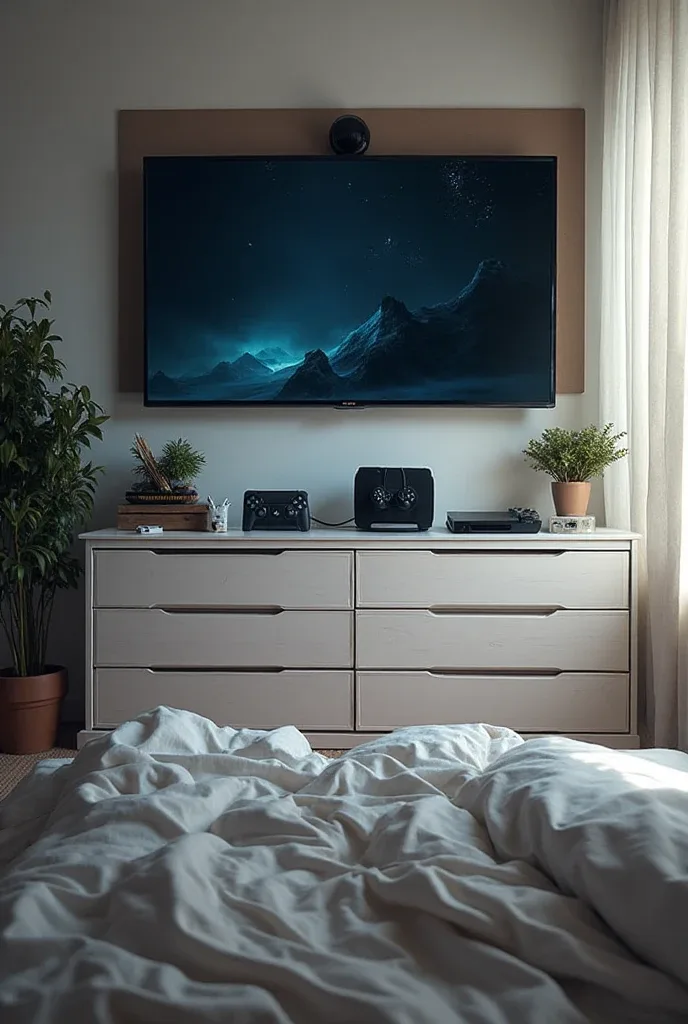
Console gaming setups on dressers eliminate desk space requirements while providing entertainment that works from bed. TV mounting above the dresser creates clean sight lines without requiring dedicated furniture.
Storage within the dresser keeps controllers and games organized while maintaining the clean aesthetic. This approach works particularly well for people who prefer console gaming or have limited bedroom floor space.
The setup feels more like bedroom entertainment than dedicated gaming, which works well in shared living situations or when you want your bedroom to maintain a more traditional appearance.
8. Natural Light Integration
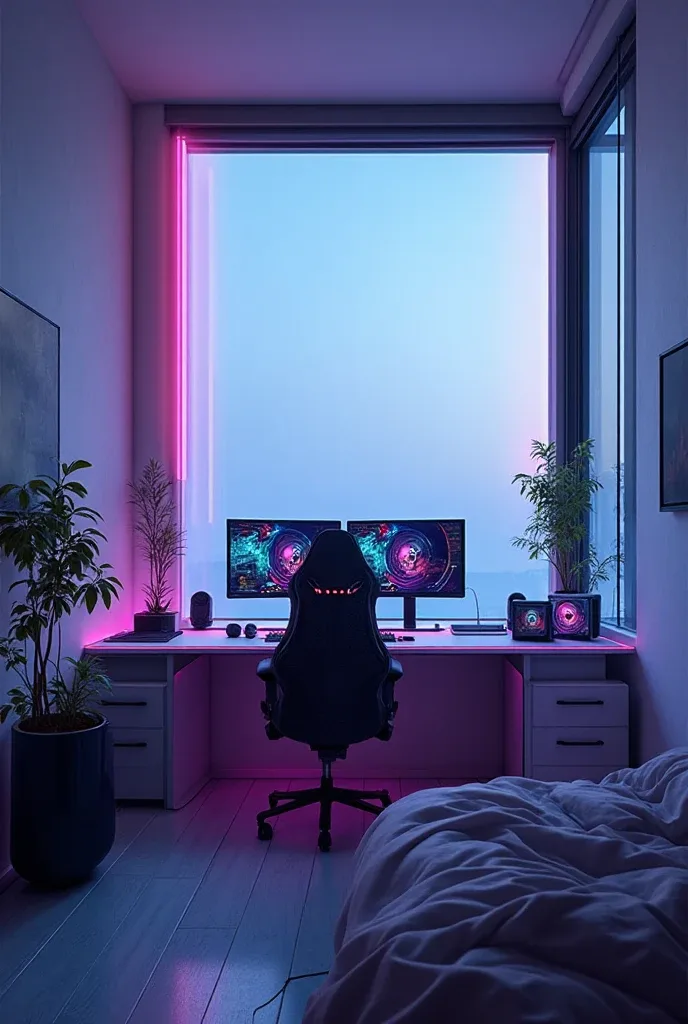
Position gaming setups near windows to take advantage of natural light during day use while managing screen glare appropriately. The balance between natural and artificial lighting creates a more pleasant environment for extended gaming sessions.
Window positioning also provides ventilation for heat-generating gaming hardware while keeping the bedroom comfortable for sleeping. Consider how different times of day affect both gaming visibility and bedroom ambiance.
This works best when you can control natural light with blinds or curtains, allowing optimization for different activities throughout the day.
9. Corner Efficiency
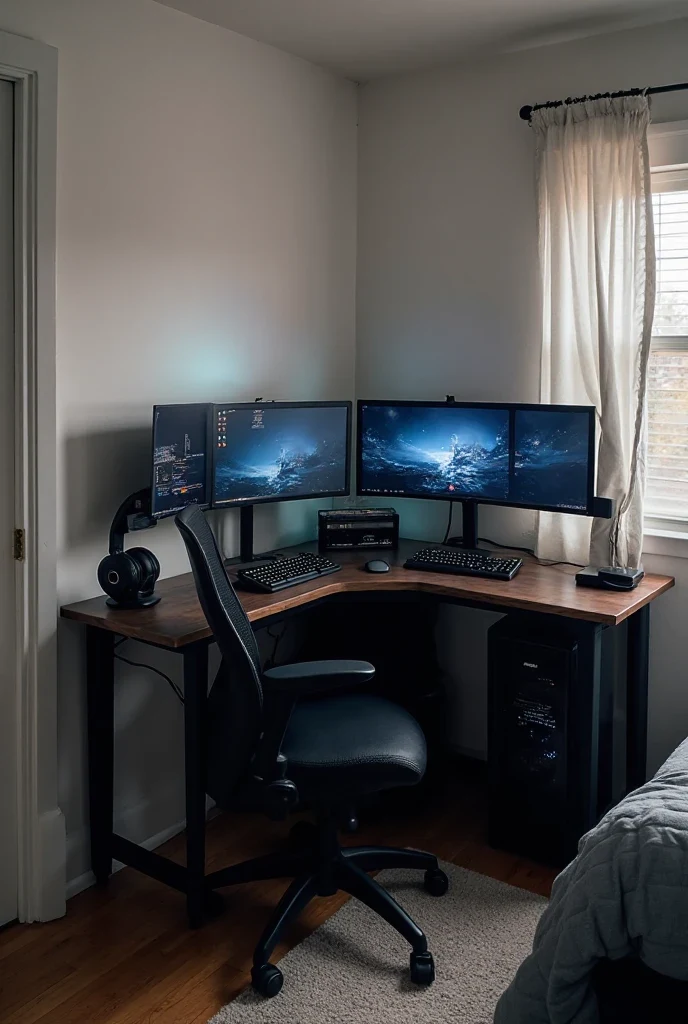
L-shaped corner configurations maximize limited bedroom floor space while providing ample gaming workspace. Angled monitor positioning creates immersive gaming while keeping the setup proportionate to bedroom scale.
Corner placement typically provides good wall support for cable management and equipment mounting while keeping pathways through the bedroom clear and functional.
This approach works well in rectangular bedrooms where corners might otherwise be wasted space, turning dead areas into highly functional gaming zones.
Also Read: 12 Gaming Desk Setup Ideas That’ll Make You Actually Want to Be Productive
10. Vertical Storage Solutions
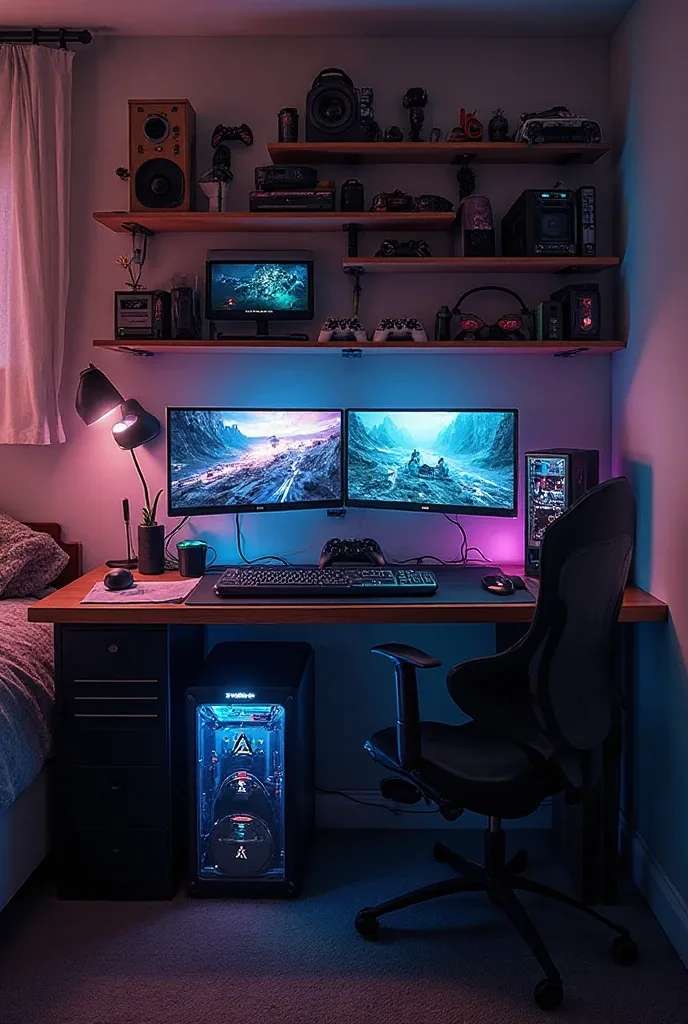
Wall-mounted shelving above gaming desks provides organized storage for controllers, games, and collectibles while keeping desk surfaces clear for actual gaming use. Proper display storage prevents clutter accumulation.
The vertical approach draws the eye upward, making bedrooms feel taller while providing practical organization that supports both gaming functionality and bedroom aesthetics.
This works well for collectors who want to display gaming gear and accessories in organized, intentional ways rather than having everything scattered across surfaces.
11. Flexible Living Space
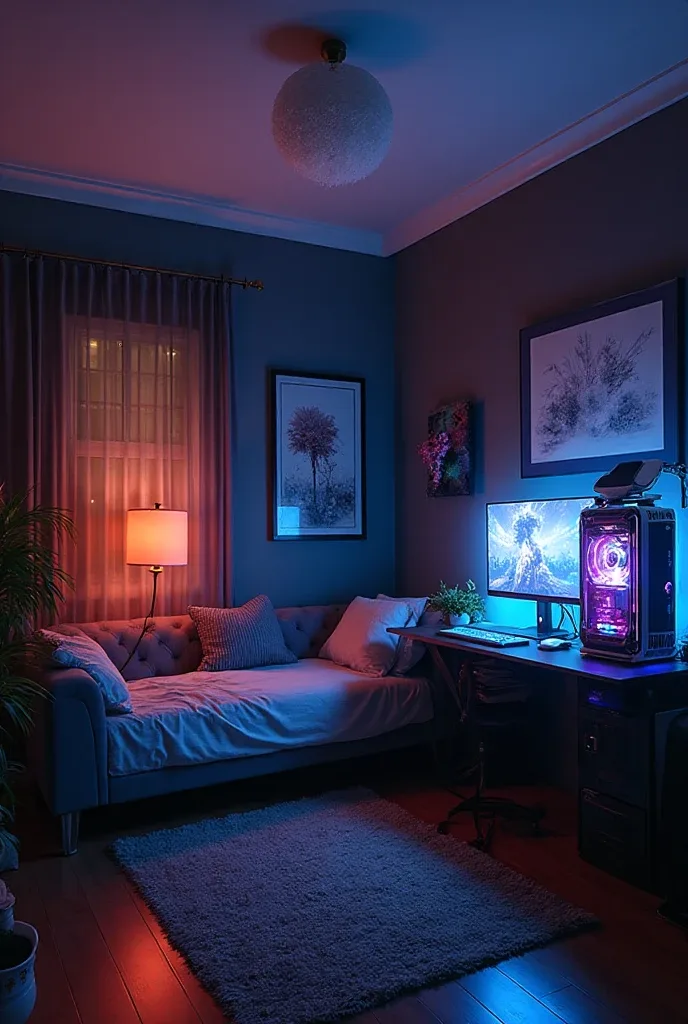
Sofa beds or daybed configurations create flexible seating that works for both gaming and bedroom relaxation. The setup can transform from daytime lounge to evening gaming to nighttime sleeping without requiring furniture rearrangement.
Gaming equipment positioned for use from the flexible seating creates options for different gaming postures and social situations—solo gaming, multiplayer with friends, or casual gaming while watching other content.
This approach works particularly well in studio apartments or small bedrooms where furniture needs to serve multiple functions efficiently.
12. Shared Space Harmony
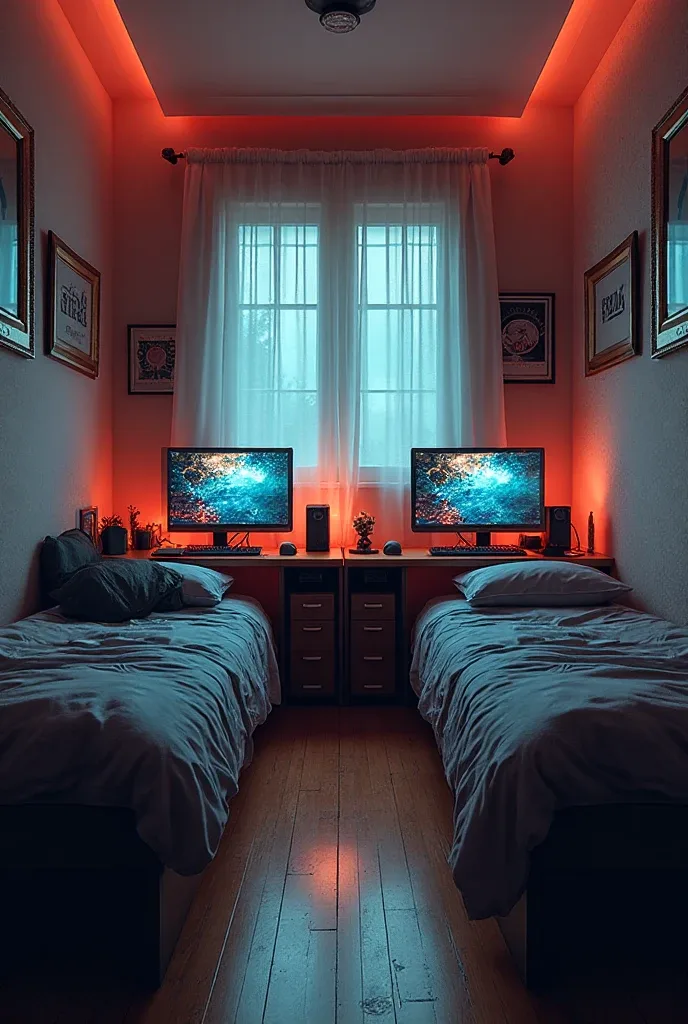
Twin bed configurations with individual gaming setups create functional shared bedrooms where both people can game without conflict. Matching equipment and symmetrical layouts create visual harmony while providing personal gaming zones.
The key is coordinating colors and equipment choices so the room feels intentionally designed rather than accidentally matched. Each setup needs full functionality without overwhelming the shared bedroom space.
This works for roommates, siblings, or couples who both game and want dedicated setups that don’t interfere with each other’s sleep or gaming schedules.
Make It Actually Work Long-Term
The reality is that gaming bedroom setups need to work for your actual lifestyle, not just your gaming aspirations. If you’re not naturally organized, don’t design a system that requires constant maintenance. If you need your bedroom to be calm for sleep, don’t create lighting that keeps you wired.
Start with the basics that affect your daily quality of life: proper cable management, lighting that works for both gaming and sleep, and equipment positioning that doesn’t interfere with normal bedroom functions.
When you find yourself sleeping better because your bedroom feels calm and organized, and gaming better because your setup actually works efficiently, you’ll understand why getting this integration right matters so much. Your bedroom should enhance both activities, not force you to choose between them.

